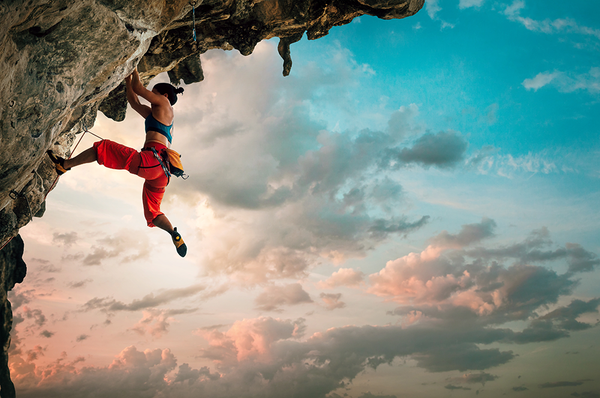Your Cart is Empty

For many, living the life of a rock climber encompasses far more than just finding a way to get a good workout and relieving the stress of everyday life. Although, physically, rock climbing is an incredible exercise plan, it is the spiritual core of a person and the emotional/mental side that finds the most pleasure when “scaling” the cliffs.

This is not a “far out” remark. After all, when looking at rock climbing from a mental standpoint, this is one physical exercise that depends on clarity, balance, determination and courage – aspects that are valuable life skills for each and every one of us. These aspects learned from becoming technically adept at rock climbing, are those that are needed in our daily lives to feel comfort and ease, while also having the adventure and excitement that comes from being a part of nature.
This is actually something the generations that came before us knew all about. There are historical and archaeological finds that prove these facts. From paintings that show Chinese men rock climbing (dated from 200 BC); to early American natives who lived in “cliff dwellings,” such as the Anasazi in the 12th century – rock climbing seems to have been a part of many centuries. One that has now, in the 21st century, grown to be a lifestyle for some.
Although rock climbing was important during the era of Victorian mountaineering in the Alps, the sport has evolved over time from a “necessity” for the Europeans to an athletic activity. Because of this evolution, everything from climbing techniques to equipment have also been transformed to fit the needs of people today.
When it comes to learning rock climbing, the most important thing to first acquire and then enhance are you skills. In other words, it is not just the “route to the top” that one needs to know about, but also how to get along that route without falling that must be taken into consideration. When it comes to the popular “free climbing,” the type of ascent you make actually falls under one of three definitions: on-sight, flash, and redpoint. When ascending on-sight, the route that you wish to take is completely unfamiliar to you; you have no knowledge beforehand of how you will make it to the top. Flashing, although similar to the first, means that the climber does have some type of information regarding the route before they take the journey; but the data is shared by others who have already accomplished the climb. Redpointing means to make a free ascent of the route, but only after having first tried it and know what is to be found.

Art Imitating Life, Get Yours Today: Click Here
It is true that the rock climbing lifestyle is about being in the Great Outdoors, and not inside a gym climbing a wall. Not surprising, considering it’s been stated by many in the medical industry that this time spent outside may decrease illness, improve the memory, enhance creativity and imagination, as well as boost your brain activity. Exercise, itself, has been shown to reduce stress, but when it comes to rock climbing, the more skilled a person is at the sport, the better it works on all levels. According to one famous university and their research, it has been proven that climbers who are completely immersed in the lifestyle and lose themselves in the climb, enter a mindset that can actually create a sense of euphoria and even block pain. And by choosing to climb outdoors, Mother Nature has shown to be the best and most useful stress reliever.
Being a versatile climber also means that you enjoy the freedom of travel – going to stunning locations that offer you a variety of challenges. Having the grand opportunity to sample a wide variety of rock choices, a climber can experience thousands of different routes and increase strength (both mental and physical) in a different way each and every time they ascend.
Ask any rock climber, and they will say the same. This is a true nomadic way of life that enhances technical development, encourages freedom of movement, and allows one and all to become a part of the natural world where they can be an explorer every day of their existence.
Take a look at the complete line of Apparel: Click Here
Comments will be approved before showing up.